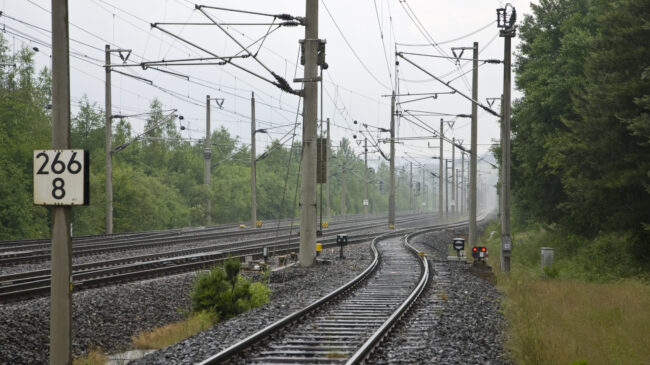The following testimony was provided by Reason Foundation to the Surface Transportation Board on February 14, 2022, in response to Docket No. EP 711 (Sub-No. 1).
Introduction
On behalf of Reason Foundation, I respectfully submit this written testimony in response to the Surface Transportation Board’s (“STB”) Notice of Public Hearing concerning proposed reciprocal switching regulations that was served on December 28, 2021. I previously submitted a notice of intent to participate at the STB’s public hearing scheduled for March 15-16, 2022.
By way of background, I am a senior transportation policy analyst at Reason Foundation and focus on matters related to transportation technology, including freight automation. I am also a member of the Transportation Research Board’s Standing Committee on Emerging Technology Law. Reason Foundation is a national 501(c)(3) public policy research and education organization with expertise across a range of policy areas, including transportation.
This testimony develops the following points:
- The STB’s proposed reciprocal switching regulations are likely to increase operational complexity at a time of unprecedented logistics network congestion;
- This rule would likely deter investment in automation technologies necessary for the industry to remain competitive with trucking over the long-run; and
- The STB should commission an updated study on competition in the railroad industry.
Adding to Supply Chain Turmoil
We are concerned that the STB’s proposed reciprocal switching regulations would unnecessarily introduce additional operational complexity and delay during a time of unprecedented logistics congestion. We expect current supply chain challenges to persist for at least another year until durable and nondurable goods demand reverts to a level closer to the pre-pandemic trend. To limit inventory disruptions and inflationary pressures, all hubs and spokes of the logistics chain require maximum flexibility permitted by regulation and private contracts.
Unfortunately, the STB’s proposed reciprocal switching regulations would add complexity and delay during unprecedented economic uncertainty. The Association of American Railroads provides an example where switching a single railcar requires 68 locomotive operations, the use of three switching yards, and six days to complete.
Even if other switching operations are less complicated, railroad economist Jim Blaze recently concluded that the STB’s proposal is likely to fail in its stated goals because “in many cases, the possible second rail carrier will decide it’s not worth trying to bid for serving selected ‘open’ locations—too time-consuming, and a shortage of crews and locomotives will make some movements too complicated for all involved.”
Deterring Automation Investment Needed to Compete with Trucks
During the last decade, automated road vehicles have captivated the public with the prospect of self-driving taxis and last-mile delivery robots improving safety and convenience. Much of the popular coverage has focused on these passenger and small cargo use cases, but development has also been ongoing in the heavy-duty truck market segment.
Waymo, formerly the Google Self-Driving Car Project, is developing fully automated long-haul trucks under its Waymo Via brand that are currently being tested on highways in the southwestern U.S. Other companies, such as Locomation, are developing cooperative automation systems that would allow trucks to automatically follow the direction of a leading truck, saving fuel through reduced aerodynamic drag and potentially labor costs if drivers in following trucks—and perhaps eventually leading trucks—can be eliminated. This technology has the potential to cut truck operating costs by nearly half and lead to the development of “road trains.” Platooning road trains have the potential to greatly reduce rail’s traditional volume advantage over trucks for numerous commodity groups.
U.S. freight railroads are now experiencing truck automation firsthand. In early February, Union Pacific and automated truck developer TuSimple announced a partnership to launch a fully automated 80-mile truck route from a Tucson railyard to a Phoenix-area distribution center.
These technologies remain under development, and wide-scale deployment is likely some years away. However, the eventual deployment of highly or fully automated heavy-duty trucks coupled with leader-follower coordination capabilities is expected to significantly reduce road freight transportation costs and impact competition between trucks and rail.
Unsurprisingly, railroads are interested in a variety of automation technologies to improve safety, productivity, and their competitive standing with other modes that are anticipated to become increasingly automated.
A 2017 article published in Transportation Research Record reported the results of a survey of railroad managers and General Electric transportation engineers on their attitudes toward rail automation. Survey responses indicate there is broad support for increased automation to mitigate safety risks, but also broad concern about technology development without train crew input, crew skill atrophy, and personnel training.
Train automation is likely to be incremental as functions are gradually automated and personnel are relieved from certain tasks as safety is assured. For instance, an incremental automation phase-in could allow for reducing train crew sizes from two to one, which Oliver Wyman in 2015 estimated could save U.S. railroads up to $2.5 billion per year by 2030. Certain lower-risk operations, such as those in railyards or those involving shorter trains, are likely to see automation technology deployed sooner. But international experience suggests fully automating at least some long-distance freight trains in the U.S. may be on the horizon.
In 2019, mining giant Rio Tinto Group successfully launched its AutoHaul fully automated train operations in Western Australia. AutoHaul involves simultaneous operation of up to 50 unmanned trains, each 1.5 miles long and carrying 240 cars of iron ore from mines to ports on an average 500-mile, 40-hour journey. Loading and unloading are completely automated, although crews still get on board and manually operate the trains as they approach terminals. Rio Tinto’s nearly $1 billion effort took over a decade of planning, development, and testing, but reductions in travel time, fuel consumption, and track and locomotive wear-and-tear have already been realized.
Fully automated freight train operations like those of Rio Tinto’s AutoHaul are unlikely to occur in the U.S. in the near term, but policymakers should begin considering the necessary changes to enable such automated operations in the future. Unfortunately, the STB’s proposed regulations on reciprocal switching would likely negatively impact railroads’ returns on investment, thereby reducing their incentive to invest in train automation research, development, and deployment. As competing freight modes are anticipated to increasingly automate and reduce labor costs—and thus total operating costs—such barriers would disadvantage railroads relative to their competitors by incentivizing customers to shift traffic from rail to highway trucks.
Among other consequences, such a modal shift would worsen environmental outcomes because when compared to freight rail on a ton-miles basis, the U.S. Environmental Protection Agency estimates that trucks emit approximately 10 times as much carbon dioxide (CO2), two-and-a-half times as much nitrogen oxides (NOX), and more than three times as much particulate matter (PM10) and fine particulate matter (PM2.5). Modal average emissions metrics are summarized in Table 1.
Table 1: U.S. Freight Transportation Emissions, Rail vs. Truck
| Freight Mode | CO2 (grams/ton-mile) | NOX (g/ton-mi) | PM10 (g/ton-mi) | PM2.5 (g/ton-mi) |
| Rail | 20.7 | 0.29 | 0.0085 | 0.0082 |
| Truck | 210.0 | 0.74 | 0.0278 | 0.0270 |
Source: U.S. Environmental Protection Agency, 2021 SmartWay Shipper Company Partner Tool: Technical Documentation, Table 12.
Pushing even a small share of freight rail traffic onto the highways would increase the transportation sector’s air pollution emissions intensity and undermine Congress and the Biden administration’s professed interest in greening transportation.
Outdated Competition Analysis
The competitive landscape in freight transportation has changed dramatically in recent decades due to both market and regulatory factors. The STB has expressed concern about a potential lack of competition in the railroad industry in recent years.
The STB’s most significant analytical undertaking was to commission A Study of Competition in the Railroad Industry and Analysis of Proposals that Might Enhance Competition from Laurits R. Christensen Associates. This study was originally released in 2008 and used data through 2006. It was then updated to include data through 2008 and released in 2010.
Not only has no anticompetitive conduct been uncovered on the part of rail carriers that would support mandatory reciprocal switching under the STB’s current rules, but statistical analysis does not support allegations of abuse of market power. The revised 2010 Christensen Associates study concluded that “increases in the railroads’ generic costs […] were driven primarily by the spike in fuel prices in recent years. Thus, while shippers have been exposed to increasing [revenue per ton-mile] after 2004, it appears that costs rather than markup factors are largely the culprits.”
The U.S. railroad industry of 2022 looks quite different than the industry of 2008, the last data year of the Christensen Associates revised competition analysis. Most strikingly, the sharp decline of coal-fired electricity generation has led coal-by-rail tonnage to decline by nearly half since 2008.
The STB recently released its Annual Rail Rate Index Study, the first since 2009 and which adds 12 years of data through 2019. These are valuable new data, but as former STB chief economist William Huneke noted, “We cannot tell from the rate study whether higher rail rates mean increasing profit margins. Rates alone do not indicate increasing profits and perhaps increasing rail carrier market power.”
In order to ensure the STB acts in the public interest, we agree with Dr. Huneke on the need for a new study on competition in the railroad industry prior to any regulatory changes aimed at addressing competition:
Railroads are a capital-intensive industry. They require large capital flows to maintain their equipment and facilities. Are they earning too much? That’s why I suggested that “STB should consider updating the Christensen study (A Study of Competition in the U.S. Freight Railroad Industry and Analysis of Proposals That Might Enhance Competition, Laurits R. Christensen Associates, Inc.).”
Merely asserting the need for new regulation to reduce rates needs more justification…. We need to know that the industry is making unreasonable, monopoly profits. To implement more regulation without a better understanding of the industry’s financial health is akin to taking a deeper dive without checking the water depth.

